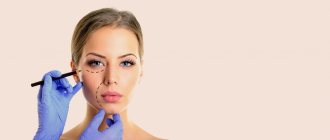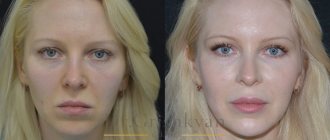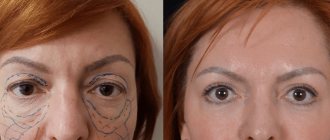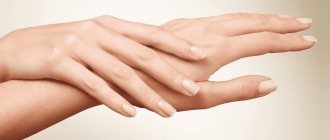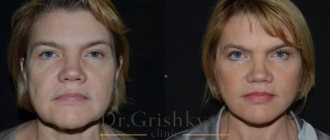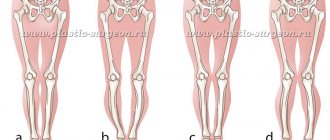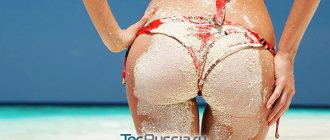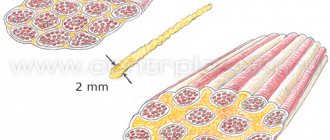- Lipofilling of lips
- Lipofilling of the area around the eyes
- Lipofilling of nasolabial folds
- Lipofilling of cheekbones
Facial lipofilling is a rejuvenating operation that corrects problem areas of the face. It is performed as an alternative to contouring based on hyaluric acid. With the help of lipofilling, the following areas are corrected and filled with the patient’s own adipose tissue:
- Upper and lower eyelid area
- Nasolacrimal groove area
- Forehead and brow area
- Zygomatic zone
- Nasolabial fold area
- Lip area and others, depending on the indications.
With age, the fatty frame of the face thins and the face becomes skeletonized, which gives the appearance a tired and aged appearance. With the help of lipofilling, comprehensive facial rejuvenation occurs, areas that have lost volume are replenished, with maximum harmonization of appearance.
Total facial lipofilling after primary rehabilitation
Total facial lipofilling: primary rehabilitation
Lipofilling can be performed both on the entire face area and on individual areas that require correction. Implantation of adipose tissue occurs through micropunctures, without cuts, which allows you to quickly go through the rehabilitation period without much discomfort for the patient.
Preparatory stage
After the patient and the doctor have determined the areas of future correction, the patient undergoes a series of laboratory tests for surgical hospitalization and a surgery date is set. The list of analyzes can be found in the “Information” section (make the word information clickable)
Preparing adipose tissue for lipofilling: how the procedure is performed
You have heard more than once that adipose tissue is processed for lipofilling. But what does it mean? An exclusive look behind the scenes.
Photo 1: Aspiration of own fat. Before re-administration, the substance must be purified, filtered and separated from its aqueous components.
Photos 2 and 3: Depending on the use for which lipofilling is planned, the extracted fat is processed using different methods before use. Various filter systems allow you to extract the desired consistency and quantity.
Photo 4: To enlarge the breasts or buttocks, more volume will be required than with an injection to eliminate wrinkles on the face. In addition, the transferred pieces of fat may be slightly larger than necessary. You can clearly see this “coarse grain” in comparison with Figure 5.
Photo 5: In the facial area it is necessary to use extremely finely processed fat: microfat substance to increase the volume of exposed parts of the body; Nanofett to be able to treat even the smallest wrinkles, age spots or scars discreetly but effectively. Particles of too large fat can, for example, show through the yellow color on very thin eyelid skin, while the skin on the buttocks and chest is much thicker.
The essence of the operation
This type of plastic surgery is performed without incisions, and exclusively through micropunctures of 2 ml. Adipose tissue is collected using a very thin cannula from a pre-selected and disinfected donor area. Most often, the donor zones are the knee zone and the “breeches” zone. Transplantation requires a very small amount of adipose tissue, which does not significantly change the outline of the donor areas.
Prepared adipose tissue for facial lipofilling
Lip lipofilling in progress
Removal of adipose tissue for lipofilling
Once the desired amount of fat is collected, it is centrifuged, purified and implanted through micro-incisions into pre-marked fat grafting areas.
The duration of the operation directly depends on the number of correction zones, and varies from 45 to 65 minutes.
Facial lipofilling
For many years, facial fat was considered a single mass, divided into a superficial plane and a deep plane in relation to the facial muscles. However, it was later discovered that the fat in these layers is divided into additional compartments separated by connective tissue membranes. Then they noticed that these fat bags can move downwards and even the fat itself in the compartments can fall down.
In parallel, some radiological studies have shown changes in the facial skeleton, which also lead to selective loss of projection in certain areas and decreased support of more superficial tissues.
This loss of support, caused by volumetric changes in the deep structures, results in loss of stability and gravitational subsidence of the overlying superficial soft tissues, thereby contributing to the ptotic appearance of the aging face.
This is why there is a need to correct not only sagging in the peripheral areas of the face and neck using facelift techniques, but also to eliminate atrophy and redistribute volume in the central area of the face using the most natural filler - your own fat.
Fat offers many benefits as a filler. It is an autologous material, non-toxic, biocompatible, non-immunogenic and non-irritating. It does not migrate and has similar physical characteristics to the tissue into which it is to be implanted. Another benefit to consider when using it as a filler is the fat's inherent ability to improve tissue and skin quality and rejuvenate the area into which it is injected. What is this connected with?
Approximately 30% of aspirated fat cells are mature adipocytes. The remaining two-thirds are formed by a highly diverse cell population, also known as the stromal vascular fraction, or SVF, which primarily includes fibroblasts, connective tissue fibers, endothelial cells and their precursors, immunomodulatory cells (eg, macrophages, lymphocytes), and also stem cells derived from adipose tissue (adipose-derived stem cells, or ADSC).
Stem cells not only improve the survival of transplanted adipocytes, but also significantly improve blood circulation in the transplant area. Immediately after lipofilling, the stem cells secrete growth hormones into the adjacent blood vessel, which leads to the formation of new tiny arteries from this vessel. The newly formed arteries are implanted into the transplanted fatty tissue and provide it with oxygen, water and nutrients. Stimulating the growth of blood vessels generally revitalizes facial tissue, which is visually reflected in improved skin quality, complexion, etc.
However, the disadvantage of fat is that it is a partially absorbable material. Like any graft that receives nutrients through plasmatic diffusion from the start of the procedure until vascularization is restored, some of its cells will be destroyed.
In order to maintain the injected volume and viability of fat, many surgeons try to enrich the fat with cells of the stromal vascular fraction or combine lipofilling with plasma lifting (or PRP). The PRP procedure involves the extraction of platelet-rich plasma from the blood by centrifugation.
The latter contains regulatory molecules that ensure tissue restoration when damaged. Under their control, connective tissue cells (fibroblasts) begin to synthesize collagen, elastin and hyaluronic acid, which are responsible for the plasticity and elasticity of the skin. In practice, the biological mechanism of natural skin rejuvenation is launched, and exclusively at the expense of the body’s own reserves.
The platelet-rich plasma is mixed with the resulting fat in one syringe and then injected into the area of deficiency.
A - adipose tissue, B - platelet-rich plasma (PRP)
Correcting facial imperfections using your own fat is called lipofilling or fat grafting. It is a surgical procedure and is performed exclusively in an operating room. Depending on the amount of fat transferred, it lasts about an hour and is performed under local anesthesia. Sometimes lipofilling can be performed as part of another major operation, such as water-jet liposuction. In this case, the removed fat can be used more rationally.
Lipofilling technique
Before the operation, the future intervention is marked in a standing position. Fat, as a rule, is taken from the most secluded places (abdomen, inner thighs, sometimes from the chin area).
The area where the fat is received and the site of its injection on the face is numbed with local anesthetics, which allows the operation to be performed absolutely painlessly for the patient.
Millimeter punctures are made with a spear-shaped scalpel at the sites where the cannula is inserted. In the future they will be practically invisible.
The fat is obtained using a blunt cannula with many tiny holes at the end, the exact diameter of the lumps of fat. A vacuum is created in the syringe, causing the fat to flow into its reservoir.
The resulting suspension contains not only fat, but also the remains of anesthetic and blood. In the vertical position of the syringe, the fat is shifted upward, and all the ballast collected at the bottom is squeezed out without hindrance. Only pure fat remains in the syringe.
To facilitate the administration of fat, it is transferred to syringes with a smaller volume.
A cannula is inserted through a puncture in the correction area. Fat is injected into the correction area, and then the skin is slightly smoothed to avoid the formation of lumps at the injection site.
At the end of the operation, punctures on the face are only treated with antiseptics and are not sutured. At the site where the fat is obtained, interrupted sutures are most often placed, which are removed on the 4-7th day.
Lipofilling of the face and neck
To achieve the most natural results, it is necessary not only to restore youthful facial contours through face lifts, neck lifts, forehead lifts and eyelid lifts, but also to add lost volume where it has been lost.
Below are the most important areas where fat grafting is performed.
Forehead, temple and around the orbit
Volumetric rejuvenation of the periorbital area and the upper third of the face significantly revitalizes the face and is an excellent complement to blepharoplasty, smoothing the transition to adjacent areas such as cheekbones, forehead and temples.
With the help of fatgrafting, you can slightly raise the tail of your eyebrows.
You can smooth out the depression in the temple area and wrinkles in the area between the eyebrows.
Using microfat, you can smooth out crow's feet along the outer edge of the orbit and improve the tear trough by injecting the emulsion through the cannula. If the skin under the eyes is dark, nanofat can improve its color by injecting it into the dermis in very small quantities.
Malar area : Correction of the negative vector of the face
In young faces, the lower eyelid is short, and the curved contour of the cheekbone, when viewed in profile, is anterior or at the level of the cornea. With age, fat in the cheek area moves downward, the lower eyelid lengthens, and the curve of the cheekbone contour flattens and moves posteriorly from the level of the cornea. This visual picture is known among professionals under the term “negative vector.” Conversion of a negative vector into a normal one is one of the most important results of fat grafting in facial rejuvenation.
Fat grafting also helps make the two cheekbones symmetrical. Due to the properties of the adipose stromal vascular fraction, skin quality also improves after injection.
Nasolabial and labiomental grooves.
Deepening of the nasolabial or labiomental grooves is one of the common signs of an aging face. And although lifting methods can significantly influence the gravitational component of these folds, they cannot correct the loss of volume that inevitably appears during the aging process.
There are many different fillers used in these areas. The choice of filler depends mainly on the depth of the folds, the quality of the skin and the patient's wishes regarding the durability of the result. The advantage of adipose tissue is its autologous nature, incomplete resorption after the procedure and cost-effectiveness, since synthetic fillers are quite expensive.
The combination of longitudinal injections along the axis of the wrinkle with transverse and perpendicular injections not only improves the filling of the groove or wrinkle, but also prevents the surrounding tissues from folding inward due to lack of support, thereby preventing the recurrence of wrinkles.
Lips
The lips are an area where fat injection has long been considered more traumatic than synthetic hyaluronic acid fillers. However, with the advent of microfat injection techniques, fat grafting took its rightful place in the correction of this zone.
Chin and jaw contour
The chin is the most prominent structure in the lower third of the face. Fat grafting in this area is a simple tool for obtaining the desired projection in patients requiring minor to moderate correction and in those who do not want intervention with foreign materials or bone surgery.
As for the contour of the lower jaw, with age, a noticeable depression sometimes appears on the sides of the chin and in front of the jowls. Although a facelift can achieve significant correction, injecting microfat into the area not only improves the results, but also helps curb the recurrence of jowls.
Nose
Nasal correction with microfat is performed according to strict indications and mainly for the correction of congenital asymmetry, the consequences of injuries and secondary rhinoplasty.
Neck area.
Microfat can also be used to correct horizontal wrinkles in the neck area.
Fat transfer can be done not only to rejuvenate the face, but also to improve the appearance of the hands.
Fat transplanted to the back of the hands covers tortuous veins and tendons, straightens thinned skin, and makes it denser.
View all
Lipofilling at Dr. Grishkyan’s clinic in Moscow
Facial lipofilling
| Operation name | Cost in rubles |
| Lipofilling of the upper eyelids | 160000 |
| Lipofilling of the lower eyelids | 160000 |
| Lipofilling of the lower eyelids with transblepharoplasty | 180 000 |
| Lipofilling of the midface, including the lower eyelids | 180000 |
| Lipofilling of the face, including the lower eyelids | 250000 |
| Facial lipofilling, including upper and lower eyelids | 310 000 |
| Lipofilling of the lower third of the face | 120000 |
| Chin lipofilling | 90000 |
| Facial rejuvenation with growth factors (“Nanofat”) | 60000 |
You are in good hands at our ETHIANUM clinic in Heidelberg
For more than ten years, the research group worked under the leadership of the founder of the clinic, Prof. Dr. med. Günter Hermann, who worked for many years in the field of autologous transplantation and told the world about the potential of autologous adipose tissue, in particular the regenerative properties of endogenous stem cells from adipose tissue.
Constant research in this field and collaboration with scientists and research institutes around the world ensure that only the most modern and gentle methods are used at the ETHIANUM Clinic in Heidelberg. The focus is also on the safety of treatment with autologous fat.
For example, in some cases we doubt the need to use autologous fat for breast augmentation surgery after removal as a result of an oncological process. Because there is a hypothesis that stem cells transferred to adipose tissue can activate the remaining dormant tumor cells. Numerous previous studies show that breast augmentation using fatty tissue can be harmful to the patient.
For this reason, the ETHIANUM Clinic in Heidelberg uses only the safe method of autologous fat transplantation. Guided by many years of experience, our specialists in lipofilling, breast enlargement using one’s own adipose tissue, undertake this type of operation only two years after completion of therapy for breast cancer, after confirming that there is no tumor growth at the local level. Currently, international research is being conducted aimed at obtaining technology that will make it possible to shorten this interval.
When does lipofilling make sense?
Precisely because autologous fat grafting is not medically necessary, but for personal and aesthetic reasons, professionalism and experience are required from the attending physician. Our specialists in this area advise and treat all patients interested in this procedure. If the procedure is not required, the doctor will do everything possible to make the patient understand that in his case there is no need for lipofilling. Main Applications:
Lipofilling in the facial area
- The folds around the mouth area may be filled with autologous fat,
- Make narrow lips look fuller or compensate for lip shape,
- Nasolabial folds, that is, wrinkles to the left and right of the nose, as well as sunken cheeks caused by loss of volume or accumulation of fatty tissue in the cheekbone area,
- Wrinkles between the eyebrows in the lower part of the forehead disappear with autologous fat injection,
- The eye area around the lower eyelids and temples looks fresher when filled with lipofiller.
Before treating wrinkles, it is determined exactly where excess fatty tissue can be removed. The areas of skin to be treated are drawn. Bring your photos to our experts so they can get an idea of what you looked like when you were younger. Thanks to photographs, our specialists will be able to perform work according to the shape of your face at a younger age.
Treatment is performed through injections of processed fat tissue using very fine needles, usually in an outpatient setting. After the procedure, it is contraindicated to exercise for 10-14 days so that the fatty tissue can be distributed evenly. Avoid extreme heat or sunlight. Any swelling usually disappears within 14 days.
